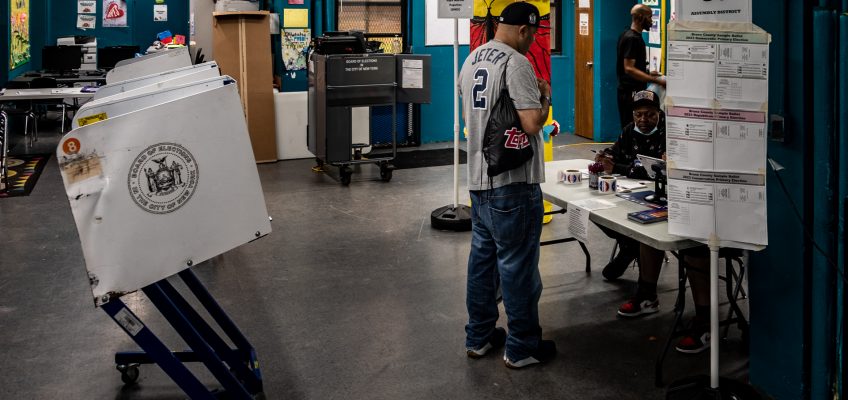Among the usually moderate public housing voters who helped power Eric Adams to the mayoralty, Zohran Mamdani outperformed expectations in last month’s Democratic primary.
The poll site at NYCHA”s Pelham Parkway Houses in 2023. (Photo by Adi Talwar)
Looking at maps of mayoral primary election results, NYCHA campuses aren’t hard to spot. Especially in fast-gentrifying areas of Manhattan, Brooklyn, and Queens, they stand out as patches of moderate votes in seas of progressivism.
Zohran Mamdani, the assemblymember from Astoria, Queens, won his home district handily. In some Astoria and Long Island City districts, he won as much as 83 percent of first-round ballots. But at two of the city’s largest public housing developments, Queensbridge and Ravenswood, Andrew Cuomo still carried the vote.
The problem is Cuomo can’t win them as handily on the final ranked-choice ballot as Mayor Eric Adams did four years ago. Where Adams ended up winning Queensbridge and Ravenswood with 72 and 68 percent of the vote respectively, Mamdani made such margins impossible by winning 30 and 35 percent of votes—just in the first round.
Under ranked-choice voting, candidates with the least number of votes are eliminated, with those ballots flowing to voters’ second choice candidates, and so on, until one candidate clears 50 percent. Most pre-election polls showed Mamdani behind on the first ballot citywide, but some gave him a chance of overtaking Cuomo in the successive rounds.
Instead, Mamdani won the first round handily, 44 to 36. Mamdani expanded the electorate dramatically with younger voters and made inroads with Latino and Asian voters.
Sherry Richards, 25, was one of the young voters. She lives in the Queensbridge houses, the city’s largest public housing development. She didn’t vote in the 2021 primary, but voted in last year’s presidential election and for Mamdani last month because of his focus on making New York more livable.
“I want a candidate that cares about New Yorkers and New York City,” she said.
While changing election district lines make a perfect comparison of results across primary years at NYCHA campuses impossible, data analysis from City Limits shows signs that Mamdani made significant inroads in traditionally moderate precincts enveloping the 19 largest public housing developments where City Limits examined data.
Outperforming expectations at NYCHA
This time around, Mamdani took up Kathryn Garcia and Maya Wiley’s mantle as the more progressive challengers to a moderate candidate (in 2021, the eventual winner Eric Adams).
Combined, Garcia and Wiley won 41 percent of the first round vote in 2021. Three weeks ago, Mamdani won 44 percent on his own. But in some precincts home to the city’s largest NYCHA campuses, he performed even better than previous contenders.
Mamdani’s victory was not just characterized by his success turning out younger voters, but his ability to remain competitive in parts of the city many wrote off for Andrew Cuomo—places like NYCHA campuses. Those inroads didn’t always show up on the map, but played a significant role.
City Limits analyzed data from large NYCHA developments because their boundaries are often contiguous with election precincts. At smaller NYCHA campuses where precincts include adjacent blocks, the data is more noisy.
City Limits mapped all NYCHA developments with the first-ballot election results so you can find your own.
Mamdani’s performance in those NYCHA precincts mirrored larger trends in the electorate. He lost Black neighborhoods and many NYCHA campuses. But he won heavily Latino neighborhoods over Cuomo, 48 to 41, according to an analysis by the New York Times. He won districts with more Asian voters 52 to 36.
His campaign did not reply to a request for comment before publication.
At the precincts enveloping the majority-Hispanic Washington Houses in East Harlem, Zohran Mamdani put up his best performance among the NYCHA campuses City Limits examined, winning 47 percent of the first round ballots, outperforming his citywide numbers.
Charisse James, who lives at the Washington Houses, voted for Eric Adams last primary but says she stayed home this time around because she didn’t feel like she knew enough about the candidates. She would have leaned towards Cuomo because of his focus on cops and public safety, but said she still wants to learn more before November.
Eric Adams won by big margins at NYCHA campuses in 2021, winning the 19 developments City Limits examined by an average of 35 points on the final ballot. Mamdani, just on first round votes, beat 2021 runner-up Kathryn Garcia’s final tally at 17 of those 19.
An early afternoon A view of NYCHA’s Jacob Riis Houses from Franklin D. Roosevelt East River Drive at East 10th Street. (Photo by Adi Talwar)
Traditionally moderate NYCHA precincts still went for Cuomo
Andrew Cuomo’s base of support came from the same parts of the city that Adams carried four years ago: outer borough districts with more homeowners and lower incomes. Those areas tended to have fewer residents with college degrees and more Black and Latino residents.
While there is tremendous diversity within the 360,000 New Yorkers who live in NYCHA, that moderate lane has traditionally resonated with public housing residents, who are lower income and disproportionately Black, Latino, and older than primary voters on the whole.
Older voters across ethnic groups, Democrat or not, tend to be more conservative ideologically, said Eli Valentin, a City Limits contributor who currently serves as assistant dean of graduate and leadership studies at Virginia Union University.
Historically, “there is a natural affinity for more moderate candidates,” like Adams and Cuomo, he said.
“They’re kind of moderate,” said Sharon Stergis of NYCHA voters. Stergis lives at the Jacob Riis houses in Alphabet City where she is part of tenant leadership. “It has a lot to do with religion and culture. [They] need stability, [they] need discipline,” she added.
Even so, NYCHA campuses don’t tend to be deep wells of votes in Democratic primaries—turnout this time around was low and relatively stable compared to 2021 across the NYCHA campuses City Limits examined.
Some residents feel they don’t get attention from public officials. “NYCHA residents, there’s a lot of apathy–complete apathy. No one ever considers campaigning amongst us. And that has been going on for generations,” said Stergis.
“I know a lot of [tenants association] presidents who supported Cuomo,” said Aixa Torres, president of the Alfred Smith Houses tenant association. But she disagreed with many of her peers on the candidates’ records on public housing, pointing to failures in getting Emergency Rental Assistance Payments out during the pandemic: “[Cuomo and Adams] have not been friends of public housing,” she added.
Torres ranked City Comptroller Brad Lander first and Mamdani second: a vote that ended up flowing to Mamdani through ranked choice voting. In 2021 she ranked Maya Wiley but left off Kathryn Garcia.
A resonant message
Mamdani was laser focused on affordability, with a campaign that touted plans for free childcare, free buses, and a rent freeze for stabilized units citywide (the rent freeze would not apply to NYCHA tenants, whose rent and contributions are determined by federal payment standards).
“This may be a repudiation of those [establishment] candidates that in many voters’ minds have done very little to alleviate the [affordability] crisis,” said Valentin.
That message may have broken through with some NYCHA voters, particularly those frustrated with establishment candidates.
“NYCHA residents understand very well what it is to struggle to survive in a New York City that’s becoming more expensive,” added Valentin.
“I want a candidate that cares about New Yorkers and New York
City,” said Sherry Richards, 25, a Queensbridge Houses resident.
(Photo by Patrick Spauster)
Richards said she was encouraged by seeing Mamdani in Queensbridge at local community events, just south of his Assembly district in Queens. His stance on affordable groceries resonated with her as well.
“This is a food desert. There’s one grocery store nearby but everything is overpriced,” she said.
A general election battleground
November’s race, five months away, features several challengers. Many Democratic leaders have coalesced around Mamdani after his stunning victory in the primary. Adams is running as an independent, as is former federal prosecutor Jim Walden. Curtis Silwa is running on the Republican line, and Cuomo re-launched his campaign as an independent last week.
Mamdani has pledged to “recommit to public housing,” calling for doubling capital investment in NYCHA, and building city-owned affordable housing on underutilized space on NYCHA campuses like parking lots.
Andrew Cuomo led the Department of Housing and Urban Development, which manages NYCHA alongside the city, from 1997 to 2001. Rich Azzopardi, a spokesperson for the campaign, told City Limits that they believe Cuomo’s experience and his plan for public housing made a strong case to NYCHA residents. His NYCHA platform includes capital upgrades, infill housing, and strategic PACT conversions.
Under Eric Adams’ administration, the city kicked off the NYCHA trust and made investments in NYCHA’s core capital repairs program through the deal for City of Yes.
In November, the moderate candidates could be competing for the same votes.
On first look, Cuomo actually outperformed Adams on the first-choice ballot at many NYCHA developments compared to last primary—but it still wasn’t enough. That dynamic may reflect a race with two clear front-runners rather than a Cuomo surge.
Where Adams would go on to win thousands of downballot votes through ranked-choice elimination, we don’t yet know how Cuomo did in these precincts in ranked choice voting. Full ranked choice voting results from the Board of Elections will not be available for a few more weeks. But Mamdani’s better-than-expected first round performance capped how much Cuomo’s lead among NYCHA voters could grow.
If Mamdani can build on the inroads he made with NYCHA voters in the general election, it could be a sign he’s headed for Gracie Mansion. Mayor Adams, whose reelection campaign has been weakened by corruption allegations, polled behind both Mamdani and Cuomo in the first polls for November.
Replicating his 2021 performances at NYCHA campuses would be a good sign for Adams’ reelection bid. He hosted NYCHA leaders at Gracie mansion earlier this month in an event that felt like a campaign rally.
The Adams’ campaign did not respond to a request for comment on this story.
During the primary, Cuomo posted a list of 27 NYCHA Tenant Association presidents who endorsed him on his website (though THE CITY reported that six of them never actually endorsed).
Stergis is an independent and, as a result, couldn’t vote in the primary. But she saw enough from Mamdani to convince her to vote in November. “I’ll vote for Mamdani. He’s a breath of fresh air,” she said.
“NYCHA residents are mostly democratic voters; they’ll be faithful to the democratic nominee,” predicted Valentin.
To reach the reporter behind this story, contact Patrick@citylimits.org. To reach the editor, contact Jeanmarie@citylimits.org
Want to republish this story? Find City Limits’ reprint policy here.
The post Mamdani’s Primary Coalition Made Inroads With Voters at NYCHA appeared first on City Limits.




